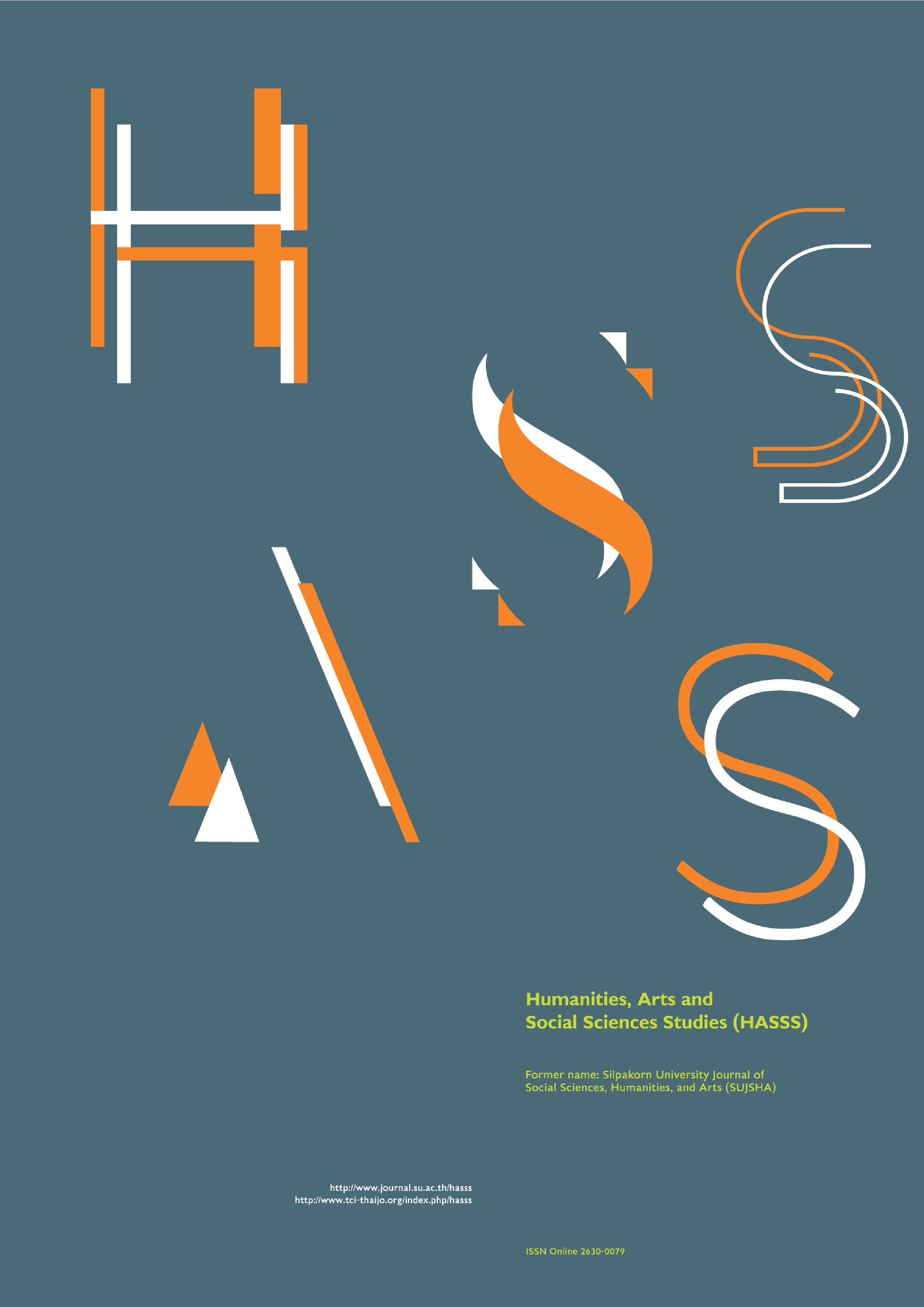The literary folk songs of Kanchanaburi Province, Thailand: The restoration and conservation of intangible cultural heritage
Main Article Content
Abstract
The objectives of this research were (1) to collect folk songs from Kanchanaburi province, Thailand; (2) to analyze the functions of the folk songs in creating community identities; and (3) to study the procedures of restoring and conserving the cultural heritage of folk songs in Kanchanaburi. The research employed purposive sampling to collect primary data from fieldwork using in-depth interviews and to obtain secondary data on Kanchanaburi folk songs recorded in writing. The research found 20 Kanchanaburi based folk songs that can be categorized into five groups: (1) conversing and flirting songs between men and women, namely, Phleng Yaei, Phleng E-Saew, Phleng Phuang Malai, Phleng Choi, Phleng Song Khruaeng, Phleng Chak, Phleng Song Fang, Phleng Phan Fang, Phleng Song Kho Lam Phuan, and Phleng Chak Kradan; (2) play songs, including Phleng Ram Thon, Phleng Khlong Chang, Phleng Khao Phi, and Phleng Choen Phi; (3) children’s songs, comprising Phleng Klom Dek, and Phleng Plop Dek; (4) bemoaning songs, containing Phleng Phitsathan, and Phleng Roi Phansa; and (5) ceremony songs, consisting of Phleng Hae Nang Maeo, and Phleng Lae Tham Khwan Nak. These folk songs serve five different functions: entertaining; reflecting the culture and strengthening the conservation of the culture; educating and cultivating world views and values of the society; acting as an emotional outlet from social pressure; and publicizing information. Four knowledge management models can be applied to restore and conserve folk songs as cultural heritage in Kanchanaburi: knowledge seeking, knowledge creation, knowledge preservation, and knowledge sharing.
Downloads
Article Details

This work is licensed under a Creative Commons Attribution-NonCommercial-NoDerivatives 4.0 International License.
All rights reserved. Apart from citations for the purposes of research, private study, or criticism and review,no part of this publication may be reproduced, stored or transmitted in any other form without prior written permission by the publisher.
References
Bascom, W. R. (1954). Four functions of folklore. The Journal of American Folklore, 67(266), 333–349.
Cultural Arts Center, Kanchanaburi Teacher’s College. (1987). Phleng Phuenban Phanomthuan Kanchanaburi [Folk songs in Phanomthuan, Kanchanaburi]. n.p. [in Thai]
Dundes, A. (1969). Folklore as a mirror of culture. Elementary English, 46(4), 471-482.
Keawkwang, W. (2012). The study of the development in performance patterns of Kwanjit Sriprachan’ phleng song kroeng “folk play”. Institute of Culture and Arts Journal, 14(1), 105–111. [in Thai]
Khumsopa, P. (1999). The analysis of Kan Truem folk songs in Dong Man Village, Surin [Unpublished master’s thesis]. Srinakharinwirot University. [in Thai]
King Chulalongkorn. (1968). Klon Dai-ari Suemsap Tam Sadet Saiyok, Khlong Nirat Thaosuphatkanphakdi, Lae Klonnarirom [The diary of an illiterate poet, the progression to Saiyok, the ballad of Tao Subhattikarabhakti, and the poems about women]. Chanwa. [in Thai]
Klaimuk, K. (1998). Inheritable processes of Pi-Phat in Bangban, Ayutthaya, Thailand [Unpublished master’s thesis]. Mahidol University. [in Thai]
Maha Thammaracha I. (1962). Traiphum Phra Ruang [Three Worlds According to King Ruang] (5th ed.). Klangwittaya. [in Thai]
Marquardt, M. J. (1996). Building the learning organization: System approach to quantum improvement and global success. McGraw-Hill.
Na Thalang, S. (1994). Nai Thongthin Mi Nithan Lae Kanlalen Kansueksa Khatichon Nai Boribot Sangkhomthai [There are tales and plays in local areas: The study of folklore in Thai context]. Matichon. [in Thai]
National Village and Urban Community Fund Office. (2001). Khumue Samrap Prachachon Phuea Triam Kan Chattang Lae Damnoen Ngan Kongthun Muban Lae Chumchonmueang [Citizen manual for preparation for the national village and urban community fund office]. http://www.villagefund.or.th/uploads/gallery/image_big_5a84a2b7cb3a4.pdf [in Thai]
Nawigamun, A. (1984). Phleng Nok Satawat Chabap Prapprung [Songs outside the century, revised edition] (3rd ed.). Mueang Boran Press. [in Thai]
Pattrachai, S. (1980). Dialogue songs: A literary analysis [Unpublished master’s thesis]. Chulalongkorn University. [in Thai]
Pattrachai, S. (1997). Phleng Patipak: Botphleng Haeng Patiphan Khong Chaobanthai [Dialogue songs: Artistry songs from Thai villagers]. The Faculty of Arts Textbook Project Chulalongkorn University. [in Thai]
Ruangdet, S. (1975). Folk songs from Phanomthuan [Unpublished master’s thesis]. Srinakharinwirot University. [in Thai]
Sirisampan, J. (2009). Phleng Phunban [Thai junior encyclopedia]. Thai Junior Encyclopedia Foundation.
Sujachaya, S. (2002). Phleng Phuenban Sueksa [Folk songs studies] (2nd ed.). Folklore Center in collaboration with the Faculty of Arts Textbook Project Chulalongkorn University. [in Thai]
Suphannayos, B. (2014). Rai-ngan Wichai Kan Ruapruam Lae Chatkep Ong-kwamru Moradok Thang Wattanatham Dan Phleng Phuenban Phakklang [Research report for collecting and storing cultural heritage data: Central region folk songs]. Department of Cultural Promotion, Ministry of Culture. [in Thai]
Taengkai Wan Songkran Chutthai Rue Sualaidok [Songkran Attire, Thai Clothes, or Floral Print T-shirts]. (n.d.). Matichon Academy. https://www.matichonacademy.com/content/article_40889 [in Thai]
Udomsilp, P. (1998). The role of Tai Phuan literatures for Thai Phuan community. Journal of Thai Language and Literature, 15, 201–233. [in Thai]
Wongthet, P. (1982). Phuenban Phuen Mueang [Native and local]. Ruankaew Printing. [in Thai]
Wongthet, S. (2016, April 15). Songthai Songkran Duai Sam Tamnan Idol Sualaidok [Ending Songkran with the 3 idol legends of ‘Floral Print Shirt’]. Matichon Online. https://www.matichon.co.th/entertainment/arts-culture/news_106869 [in Thai]


